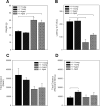Region Specific Effects of Aging and the Nurr1-Null Heterozygous Genotype on Dopamine Neurotransmission
- PMID: 28989991
- PMCID: PMC5630175
- DOI: 10.4172/2469-9780.1000114
Region Specific Effects of Aging and the Nurr1-Null Heterozygous Genotype on Dopamine Neurotransmission
Abstract
The transcription factor Nurr1 is essential for dopamine neuron differentiation and is important in maintaining dopamine synthesis and neurotransmission in the adult. Reduced Nurr1 function, due to the Nurr1-null heterozygous genotype (+/-), impacts dopamine neuron function in a region specific manner resulting in a decrease in dopamine synthesis in the dorsal and ventral striatum and a decrease in tissue dopamine levels in the ventral striatum. Additionally, maintenance of tissue dopamine levels in the dorsal striatum and survival of nigrostriatal dopamine neurons with aging (>15 months) or after various toxicant treatments are impaired. To further investigate the effects of aging and the Nurr1-null heterozygous genotype, we measured regional tissue dopamine levels, dopamine neuron numbers, body weight, open field activity and rota-rod performance in young (3-5 months) and aged (15-17 months) wild-type +/+ and +/- mice. Behavioral tests revealed no significant differences in rota-rod performance or basal open field activity as a result of aging or genotype. The +/- mice did show a significant increase in open field activity after 3 min of restraint stress. No differences in tissue dopamine levels were found in the dorsal striatum. However, there were significant reductions in tissue dopamine levels in the ventral striatum, which was separated into the nucleus accumbens core and shell, in the aged +/- mice. These data indicate that the mesoaccumbens system is more susceptible to the combination of aging and the +/- genotype than the nigrostriatal system. Additionally, the effects of aging and the +/- genotype may be dependent on genetic background or housing conditions. As Nurr1 mutations have been implicated in a number of diseases associated with dopamine neurotransmission, further data is needed to understand why and how Nurr1 can have differential functions across different dopamine neuron populations in aging.
Keywords: Dopamine; NR4A2; Parkinson’s disease.
Figures




Similar articles
-
Early postnatal isolation reduces dopamine levels, elevates dopamine turnover and specifically disrupts prepulse inhibition in Nurr1-null heterozygous mice.Neuroscience. 2006 Jul 21;140(4):1117-26. doi: 10.1016/j.neuroscience.2005.12.065. Epub 2006 May 9. Neuroscience. 2006. PMID: 16690213
-
Alterations in amphetamine-stimulated dopamine overflow due to the Nurr1-null heterozygous genotype and postweaning isolation.Synapse. 2008 Oct;62(10):764-74. doi: 10.1002/syn.20550. Synapse. 2008. PMID: 18655117
-
Reduced tyrosine hydroxylase and GTP cyclohydrolase mRNA expression, tyrosine hydroxylase activity, and associated neurochemical alterations in Nurr1-null heterozygous mice.Brain Res Bull. 2006 Jun 30;70(2):186-95. doi: 10.1016/j.brainresbull.2006.05.004. Epub 2006 May 22. Brain Res Bull. 2006. PMID: 16782508
-
The role of Nurr1 in the development of dopaminergic neurons and Parkinson's disease.Prog Neurobiol. 2005 Sep-Oct;77(1-2):128-38. doi: 10.1016/j.pneurobio.2005.09.001. Epub 2005 Oct 21. Prog Neurobiol. 2005. PMID: 16243425 Review.
-
5-HT1A receptor-dependent control of nigrostriatal dopamine neurotransmission in the pharmacotherapy of Parkinson's disease and schizophrenia.Behav Pharmacol. 2015 Feb;26(1-2):45-58. doi: 10.1097/FBP.0000000000000123. Behav Pharmacol. 2015. PMID: 25503261 Review.
Cited by
-
Wnt1 silencing enhances neurotoxicity induced by paraquat and maneb in SH-SY5Y cells.Exp Ther Med. 2019 Nov;18(5):3643-3649. doi: 10.3892/etm.2019.7963. Epub 2019 Aug 30. Exp Ther Med. 2019. PMID: 31602242 Free PMC article.
-
NURR1 deficiency is associated to ADHD-like phenotypes in mice.Transl Psychiatry. 2019 Aug 27;9(1):207. doi: 10.1038/s41398-019-0544-0. Transl Psychiatry. 2019. PMID: 31455763 Free PMC article.
-
NURR1-deficient mice have age- and sex-specific behavioral phenotypes.J Neurosci Res. 2022 Sep;100(9):1747-1754. doi: 10.1002/jnr.25067. Epub 2022 May 20. J Neurosci Res. 2022. PMID: 35593070 Free PMC article.
-
Nurr1 Is Not an Essential Regulator of BDNF in Mouse Cortical Neurons.Int J Mol Sci. 2022 Jun 20;23(12):6853. doi: 10.3390/ijms23126853. Int J Mol Sci. 2022. PMID: 35743300 Free PMC article.
References
-
- Solanto MV. Dopamine dysfunction in AD/HD: integrating clinical and basic neuroscience research. Behav. Brain Res. 2002;130:65–71. - PubMed
-
- Merims D, Giladi N. Dopamine dysregulation syndrome, addiction and behavioral changes in Parkinson’s disease. Parkinsonism Relat. Disord. 2008;14:273–280. - PubMed
-
- Zetterström RH, Solomin L, Jansson L, Hoffer BJ, Olson L, et al. Dopamine neuron agenesis in Nurr1-deficient mice. Science. 1997;276:248–250. See comment in PubMed Commons below. - PubMed
Grants and funding
LinkOut - more resources
Full Text Sources
Other Literature Sources
Research Materials
